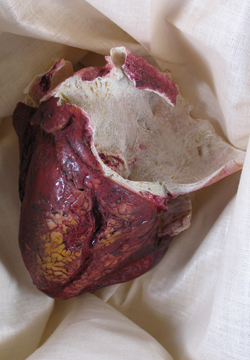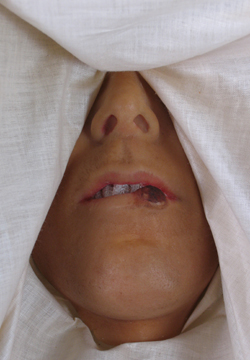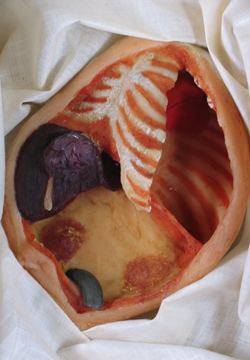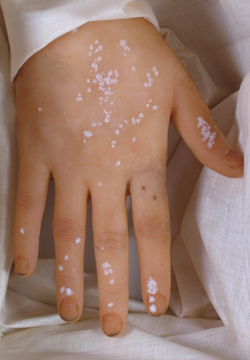 |
Mitral stenosis |
 |
Carcinoma |
 |
Diaphragmatic hernia (newborn) |
 |
Hand psoriasis |
Moulage (pronounced moo-lahzh) is the art of applying mock injuries or conditions for the purpose of training medical and nursing students and other medical personnel. It is a French term for a mold of a lesion or defect, which is used as a guide in applying medical treatment or in performing reconstructive surgery (especially on the face).
Moulage has a long history of use in medical education. It may be as simple as applying pre-made rubber or latex “wounds” to a healthy “patient’s” body, or as complex as using complicated makeup and theatrical techniques to provide elements of realism (such as blood, vomitus, open fractures) to the training simulation.
UNMC has a modern-day master of moulage: Click here for more information.
The history of wax models is ancient. The practice dates to at least the Renaissance, when wax figures were used for this purpose. Wax anatomical models were first made by Gaetano Zummo (1656-1701), who worked in Naples, Florence, and finally Paris, where he was granted monopoly rights by Louis XIV. Later, Jules Baretta (1834-1923) made more than 2,000 wax models at the Hospital Saint-Louis, Paris, where more than 4,000 wax models were collected.
In the 19th and early 20th centuries, moulages were taken of patients for medical educational purposes. The prepared model was painted to mimic the original case and disease.
The McGoogan Library has more than 100 moulages, made here on the UNMC campus, probably in the 1930s. The moulages are molded wax on a plaster base; they were made by David Rhea, a laboratory assistant in charge of tissue processing for the pathology department, under the direction of Perry Tollman, M.D., chair of the department from 1948-1952, and later dean of the College of Medicine from 1952-1964. Rhea molded the models and Dr. Tollman was involved as an advisor for the authentication of each one. They were all based on patient cases from the former University Hospital.
The moulages were donated to the library in 2003, through the efforts of Pete Iwen, Ph.D., professor of pathology and microbiology; their provenance was documented by Jim Newland, M.D., professor emeritus of pathology and microbiology, in his history of the department. Before being donated to the library, the moulages were housed in the main hallway of the North Laboratory Building (Poynter Hall), and later in a fourth-floor pathology classroom in Wittson Hall.
The moulages are on exhibit on the sixth and eighth floors of the library.
As always, most interesting, John. I read a UNMC today article last year about someone on campus that is still making the moulages today. Possibly the collection can grow when the user department is finished with them….